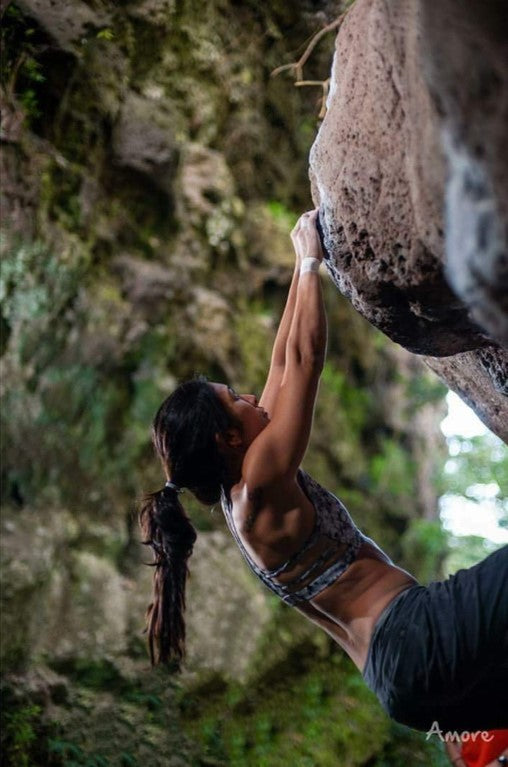
"Come on!" "Gamba!" by Mad Rock Athlete Sonomi Imagawa
Above: Pre-injury climbing session at Green Boulders, Oahu, HI. Photo by, Sean Amore
Example of poor shoulder positioning. Notice shoulder blade winging and shrugging as a result of overused trapezius, or traps.
June 2020
Sitting on the mats below the bouldering wall at my local climbing gym, I shout words of encouragement as I watch fellow climbers hurl themselves up the wall. As I am observing, in envy, I notice something that I have never recognized before. Some climbers' shoulder blades shift away from their spines into what closely resembles bird wings as they reach above their heads, and their necks disappear as soon as they match their hands on a handhold in a desperate attempt to set up for the following sequence.
Six months Earlier: January 2020
After completing nearly three hundred hours of physical therapy and developing genuine hatred toward exercise bands and anybody who uses the words, you, should, and rotator cuffs in the same sentence, I tried to climb again. It was great at first - I worked my way up the V-ladder very quickly. There was only one issue: it hurt. I practiced single hard moves that forced me to twist my shoulder in awkward positions, then, "Pop!" I am on the ground again and again with a dislocated shoulder. "Why does this keep happening?" I thought, "I rehab and work out every damn day!" How many of us have asked ourselves similar questions and felt frustration from our efforts not translating to sending harder climbs?
Well, I later learned the answer for me was quite simple: I was training hard in all the wrong ways. I was doing exercises that reinforced my bad habits without realizing it. Such a lack of body awareness repeated over many years caused me to get stuck in the same patterns that eventually resulted in a labral tear in my shoulder.

Above: Pre-injury training session at VRG, Honolulu, HI. Photo by Ryan Colle
Exercise: 1-3-5-9 on campus board. Another example of overused traps and lack of core activation.
February 2020
I cried a lot more than I ever want to admit and consulted more physicians and physical therapists than I could afford. Then an athletic trainer referred me to Dan Hislop, the strength and conditioning coach for football and swim & diving at the University of Nevada, Reno. He offered to work with me, not on rehab, but strengthening.

Above: Reno, NV. Photo by, Kyle Ray
(Right) Dan Hislop, strength and conditioning coach for football and swim & diving at the University of Nevada, Reno.
On day one, we completed a series of bodyweight exercises to assess my level of fitness. I realized within the first five minutes of my session with Dan that I had my work cut out for me. He had me crawling on all fours focusing on core activation and scapular protraction. I felt beads of sweat dripping down my face after completing only ten feet of what ended up becoming the most challenging drill of my life.
Phase 1, Day 1: Back to the Basics
|
*Pre-workout |
Forward Crawling: 2x10 yards |
|
|
Serratus Supine Reach: 3x10 second hold |
|
|
Scapular Protraction and Retraction: 3x5 |
|
Exercise A1 |
Neutral Grip Pull-up: 3x3 **Tempo: 3/0/x/2 |
|
Exercise B1 |
Goblet Squat: 3x5 Tempo: 5/0/x/0 |
|
Exercise B2 |
Deadbug: 3x8 each side |
|
Exercise C1 |
Chest Supported Row: 3x5 Tempo: 0/0/x/2 |
|
Exercise C2 |
Front Plank: 3x20 seconds |
|
Exercise D1 |
Barbell Romanian Deadlift: 3x5 Tempo: 3/0/3/0 |
|
Exercise E1 |
Kettle Bell Carry: 2x30 yards |
|
*Left column indicates the flow of the workout. Do all exercises in each alphabetical category in order. If there are multiple exercises per alphabet, complete the exercises as a superset, or one right after another. **Tempo: Time under tension. · The first number represents the number of seconds it takes to complete the start of the movement (up or down). · The second number represents the number of seconds in a pause at the end of the first movement. · The third number represents the number of seconds it takes to complete the second movement of the exercise (up or down). X denotes an explosive motion. · The last symbol represents the number of seconds to pause at the end of the second motion. |
|
Dan designed the workouts in phases. This phase was to help me reset and to teach myself how to engage the muscles that I have not been using all this time. Each exercise is a part of a progression and can be altered for increased difficulty over time.

Above: Reno, NV. Photo by, Kyle Ray
Exercise: Deadbug with medicine ball. Deadbugs can start with no weight and eventually progress to include bands and weight for increased resistance.

Above: Reno, NV. Photo by, Kyle Ray
Exercise: Barbell Row
May 2020
"Shoulders back, show the rack," repeated in my mind like a ceremonial chant as I worked my way up a V0. I calculated each move, pulled my shoulder blades back, shifted my weight, moved my feet, and suddenly I felt like I was floating up the wall. It felt effortless, and I was finally climbing how I'd always dreamt of climbing. I feel strength and elegance all at the same time, and I owe it all to weightlifting and Dan's instruction.

Above: Base Camp Climbing Gym, Reno, NV. Photo by, Kyle Ray
Post training climbing session. Notice the shoulder blades are pushed back and down.
Phase 2, Day 2:
|
Pre-workout |
Kneeling Serratus Anterior with PVC Pipe: 3x6 Tempo: 0/0/x/5 |
|
Exercise A1 |
Hang Clean Pull: 4x2 |
|
Exercise B1 |
Goblet Reverse Lunge: 4x5 each side |
|
Exercise B2 |
Deadbug: 3x5 |
|
Exercise C1 |
Neutral Grip Pull-up: 4x2 (increasing weight each set) |
|
Exercise C2 |
Single Arm Dumbbell Bench Press: 4x5 Tempo: 0/2/x/0 |
|
Exercise D1 |
Goblet Lateral Lunge: 3x5 each side |
|
Exercise D2 |
Back Extension: 3x6 Tempo: 3/0/x/5 |
|
Exercise D3 |
Single-leg Squat to Bench: 4x6 Tempo: 4/0/x/0 |
|
Exercise E1 |
Goblet Carry: 3x30 yards |

Above: Reno, NV. Photo by, Kyle Ray
Exercise: Kneeling Serratus Anterior with PVC Pipe. Function: Lower trap activation.

Above: Reno, NV. Photo by, Kyle Ray
Exercise: Neutral Grip Pull-up
June 2020
I learned that weightlifting is a skill. It requires close attention to form, and it isn't always possible to notice our shortcomings. Having a trainer helped me understand the ways I compensate movements and recognize the cues to complete exercises with proper form. I also learned that I had developed a motor pattern throughout my years of climbing that most likely caused my shoulder injury. It was my lats or latissimus dorsi to be exact, but where were they all this time?
Dan reminded me over and over to push my shoulders down and engage my lats. He continued to tap my mid-sides (near the shoulder blades) during exercises to cue me to use previously neglected muscles. Then, after about a month, it clicked. Those pull-ups that always gave me pain no longer hurt. My shoulders were more stable on the climbing wall than they have ever been. The best part of it all was that my body awareness increased, and I can now identify the muscles that are not activating when they should be during specific movements on the climbing wall.

Above: Base Camp Climbing Gym, Reno, NV. Photo by, Kyle Ray
Post training climbing session.
I didn't start to notice a difference in my climbing until phase 3 of my training plan. Despite the COVID-19 outbreak, I continued to train three days a week, which included facetime sessions with Dan. I saw a significant change in the positioning of my shoulder blades, and it was all happening naturally.
Phase 3, Day 1:
|
Pre-workout |
Lateral Bear Crawl: 3x5 yards each side |
|
Pre-workout |
Wall Ball Rotation: 3x10 seconds each side |
|
Exercise A1 |
Hang Power Clean: 2x3 and 2x2 (increasing weight after each set) |
|
Exercise B1 |
5 Position Front Squat (quarter, half, full, half, quarter): 4x3 Tempo: 0/2/x/0 |
|
Exercise B2 |
Hard Roll Hold: 3x3+3 breathes each side |
|
Exercise C1 |
Pull-up: 2x3 and 3x2 Tempo: 0/0/x/1 (increasing weight after each set) |
|
Exercise C2 |
Hollow Rocks: 4x15 |
|
Exercise D1 |
Single-leg Romanian Dead Lift: 4x4 each side |
|
Exercise D2 |
Bat Wings with kettlebells: 4x15 second hold |

Above: Reno, NV. Photo by, Kyle Ray
Exercise: Front squat starting position

Above: Reno, NV. Photo by, Kyle Ray
Exercise: Front squat lowered position with corrections from Dan.

Above: Reno, NV. Photo by, Kyle Ray
Exercise: Single-leg RDL with kettlebell

Above: Reno, NV. Photo by, Kyle Ray
Exercise: Hard Roll Hold

Above: Reno, NV. Photo by, Kyle Ray
Dan demonstrating front squat form and elbow positioning for power cleans.
Power cleans taught me more than just how to lift weights into the air. It taught me an unimaginable amount of body awareness. It may not be immediately apparent as a relevant exercise for climbing, but to be honest, this exercise was a game-changer for me. It is a full-body explosive motion that taught me how to generate power from my legs while maintaining a strong core and shoulders. It also changed the way I approach moves in climbing. Before, I often opted for a "whatever it takes" approach to stick the move. Now I can identify every muscle that needs to engage and its approximate percentage of capacity before I set foot off of the ground.

Above: Base Camp Climbing Gym, Reno, NV. Photo by, Kyle Ray
Post training climbing session.
Many climbers have given me varying advice for climbing harder. Climb more, hang board, campus board, yoga, calisthenics, you name it. These may all be very true, but I believe the key to my climbing was the development of my mind-muscle connection. Weightlifting enabled me to complete challenging repetitive movements and having a strength coach allowed me to develop the correct patterns of movement.

Above: Kirkwood, CA Photo by, Laure Saint Georges
Keep in mind that I am not an expert in exercise physiology, nor am I certified to give anybody medical advice. I am writing this blog to reflect on how I changed my cross-training methods over the last six months and how it affected my climbing.
I can say with confidence that training with a professional strength coach was the best investment I have ever made for my health. Learning how to perform exercises with correct form was not only good for my shoulders but it also significantly improved my knowledge of body positioning. Now, as I sit below the bouldering wall observing fellow climbers, I pay particular attention to their intricate movements beyond the simple positioning of their limbs. I can see very clearly, the activation of specific muscles and how it propels them to move up the wall.

Above: South Lake Tahoe, CA Photo by, Kyle Ray
For more information about training with Dan Hislop, contact dhislop@unr.edu. Dan offers in person one-on-one sessions, small group sessions, individualized workout plans, and online face-to-face workout sessions.
